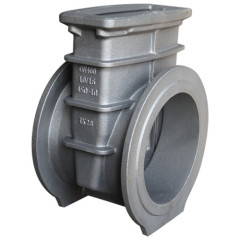
|
Hebei Jinli Casting Inc.
|
malleable iron pipe fittings
| Place of Origin: | Shanxi, China (Mainland) |
|
|
|
| Add to My Favorites | |
| HiSupplier Escrow |
Product Detail
Malleable iron is cast as white iron, the structure being a metastable carbide in a pearlitic matrix.
Malleable iron is cast as white iron, the structure being a metastable carbide in a pearlitic matrix. Through an annealing heat treatment, the brittle structure as first cast is transformed into the malleable form. Carbon agglomerates into small roughly spherical aggregates of graphite leaving a matrix of ferrite or pearlite according to the exact heat treatment used. Three basic types of malleable iron are recognized within the casting industry: blackheart malleable iron, whiteheart malleable iron and pearlitic malleable cast iron.
Like similar irons with the carbon formed into spherical or nodular shapes, malleable iron exhibits good ductility. Incorrectly considered by some to be an "old" or "dead" material, malleable iron still has a legitimate place in the design engineer's toolbox. Malleable iron is a good choice for small castings or castings with thin cross sections (less than 0.25 inch, 6.35 mm). Other nodular irons produced with graphite in the spherical shape can be difficult to produce in these applications, due to the formation of carbides from the rapid cooling.
Malleable cast iron also exhibits better fracture toughness properties in low temperature environments than other nodular irons, due to its lower silicon content. The ductile to brittle behavior transformation temperature is lower than many other ductile iron alloys.
In order to properly form the spherical-shaped nodules of graphite during in the annealing process, care must be taken to ensure that the iron casting will solidify with an entirely white iron cross section. Thicker sections of a casting will cool slowly, allowing some primary graphite to form. This graphite forms random flake-like structures and will not transform to carbide during heat treatment. When stress is applied to such a casting in application, the fracture strength will be lower than expected for white iron. Such iron is said to have a 'mottled' appearance. Some countermeasures can be applied to enhance the formation of the all white structure, but malleable iron foundries often avoid producing heavy sections.
After the casting and heat treatment processes, malleable iron casting can be shaped through cold working, such as stamping for straightening, bending or coining operations. This is possible due to malleable iron's desirable property of being less strain rate sensitive than other materials.
It is often used for small castings requiring good tensile strength and the ability to flex without breaking (ductility). Uses include electrical power fittings, hand tools, pipe fittings, washers, brackets, fence fittings, power line hardware, farm equipment, mining hardware, and machine parts.
































